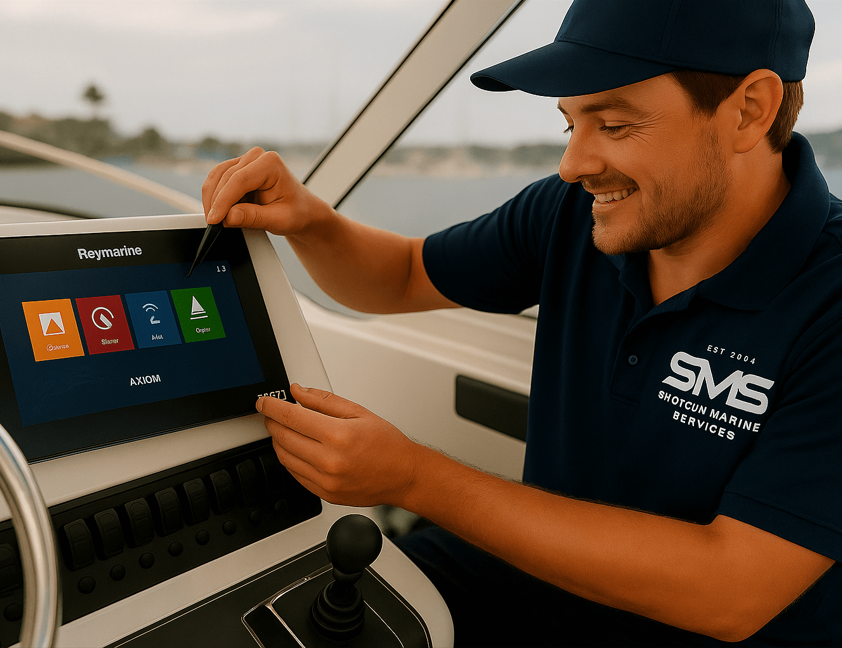The Question that is always asked
Which Transducer should I use? Which is best? What's the difference?
There are quite a few factors that really need to be looked and and considered to work out which transducer will suit your needs. :
- Housing
- Installation Options
- Display needed
- Energy/power
- Frequency
- Beam angle
Housing Material
Initially you need to work out what you need the transducer to be should be composed of.
Plastic housings are suited for fiberglass or metal hulls.
Stainless Steel housings are work best with steel or aluminium hulls.
Bronze housings come recommended for fiberglass or timber boats.
Bronze is preferable to plastic for In relation to timber clinker hulls the bronze is preferred the reason is that is possible that with the expansion of wood – damage could occur with a plastic transducer in and turn result in leaks. Installation of stainless housing in a metal hull needs an insulating fairing, available from Shotgun Marine.
Housings made from Metal should NOT be installed in a vessel with a positive earth.
Mounting Options
Also the installation/mount of each transducer is an important factor to consider.
- Through-hull with fairing blocks perform the best of all and exceptionally well at high speeds.
- Through-hull flush mounts suited more for the smaller trailerboat setup. Good results with nothing protruding out from the hull.
- In-hull transducers for those who do not want holes in their hull but that results in less performance.
Display
It is important to make sure your selected transducer possesses the features that you will need to see displayed for example: speed, depth, temp or combo.
Transducer Power
Power denotes the strength that the transducer directs the sonar "ping", in watts RMS. Greater power intensifies the chances of receiving a return echo deep water or poor conditions with much clearer detail like bait fish and sea bed structure. Generally, the more power means more depth allowing for simplicity to separate echoes coming back up from below. Including fish & bottom structure.
Transducer Frequency
The accurateness with which your fishfinder distinguishes fish, objects and bottom is determined by the frequency selected for the depth you are looking at. Most depth transducers can be tuned to 2 different frequencies: Both high and low. - 200 kHz or 50kHz
200 kHz is for water under sixty meters to two hundred feet along with necessity to gain a precise reading travelling higher speed. Much higher detail with high frequency to detect the smallest of target over a less water. High frequencies characteristically show less noise and fewer unrequired echoes all the while giving defined target definition.
200 kHz Echo Sounder Display in 50' (15m) of water
In comparison, low is preferred for deep water. Reason being; water absorbs sound waves slowly with low frequency with the signal able to travel further. The cone angle of the beam is wider with low freq, and the outgoing pulse range more being far better suited if you need to view large areas underneath the vessel. But this compromises the target definition and separation with more unwanted noise possible. Generally low frequency can see deeper but not necessarily clearer.
The general rule of thumb is to take the 200 kHz setting for a comprehensive view to about 200 feet and then change to 50 kHz when you want to see deeper. Optimal is to get both views next to each other by way of splitscreen. Getting the best of both worlds.
50 kHz Echo Sounder Display in 50' (15m) of water.
Cone Angles
The transducer focuses the diffused sound into a cone like beam. In theory, the emitted pulse radiates to the shape of a cone, getting widening as it goes deeper. Basically, beam transmission shapes can vary by transducer choice typically display "side lobe" patterns. The following image below shows the transducer's real transmit radiation patterns.
Low frequencies have wider beam angles than high frequencies.
With the transmission signal being strongest around the water column centre of the cone slowly reduces moving away from the center. The wider angle gives a bigger view of the bottom, but sacrifices the clarity because it spreads transmitter's power. The narrower cone focuses the transmitter's power into a smaller space. Cone angles basically - wider at low frequency and narrower at high frequencies.
So in conclusion the rule is, a wide cone angle identify fish not only under the vessel but also around the boat but with less target separation. A narrow cone only scans a small amount of water at a time which concentrates the sound thus enabling improved detection of minor details, such as fish or bottom object structure,.
In actuality, beam forms differ with the transducer type and naturally exhibit "side lobe" patterns.


